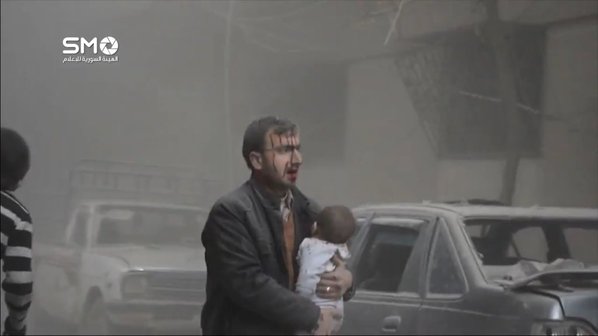PHOTO: Man carries a child after an airstrike on the Damascus suburb of Douma, December 2015
A new report from a Syrian NGO makes the claim that 470,000 people have died, directly or indirectly, from the conflict since March 2011.
The Syrian Center for Policy Research, in cooperation with the UN Development Program, includes this brief reference in a report focusing on the economic impact of the war, “Confronting Fragmentation“:
The armed conflict badly harmed human development in Syria where the fatalities in 2015
reached about 470,000 deaths, the life expectancy at birth [is now] estimated at 55.4 years, and the school age non-attendance rate projected at 45.2 per cent.
Even though the statement is deep inside a Concluding Summary, it has been converted into a headline by The Guardian, “Report on Syria Conflict Finds 11.5% of Population Killed or Injured”.
If verified, the claim would be a significant increase on the general declarations of casualties from the conflict. The UN, which drew on data from eight sources claiming to track the dead and injured, stopped posting a count in January 2014, although it put out an estimate of 250,000 dead in in August 2015. The oft-cited Syrian Observatory for Human Rights gave a toll of more than 260,000 in January 2016, but the “monitoring group” has never provided support for its numbers.
The problem with the latest claim from the SCPR is that there is no methodology or sources for its sweeping claim. Instead, the report asserts a still-unpublished survey for 2014 and a projection — not a confirmation — of the 11.5% killed and injured headlined by the Guardian:
The results of population status, 2014 survey show that 1.4 per cent of the Syrian population lost their lives. Among those 11.4 per cent of the mortalities were children, bringing the rate of mortality up from 4.4 per 1000 in 2010 to 10.9 per 1000 in 2014.
By the end of 2015, the death rate is projected to be 10 per thousand, with the number of wounded expected to reach 1.88 million people. This estimates that 11.5 per cent of the population inside Syria were killed, injured or maimed due to the armed-conflict in 2015.
The report does have significant information, with far more support, about the social and economic crisis in Syria. Life expectancy has fallen from 70 in 2010 to 55.4 in 2015. Overall economic losses are estimated at $255 billion, based on an assessment of confirmed damage — an amount equal to 468% of Syria’s GDP in 2010. Both public and private investment continued to fall in 2015, by 31.8% and 5% respectively, with private investment now making up only 9% of the economy.
With the further downturn, unemployment reached 52.9%. The overall poverty rate is estimated at 85.2% by the end of 2015, with 69.3% in “extreme poverty” and 35% in “abject poverty”, defined as “being unable to meet the basic food needs of their households”.
All of this deserves attention, as does the continuing death toll, the majority of which is caused by Russian bombing and attacks by the Syrian military and its other allies.
But the point remains that — even as a well-placed local source says the SCPR’s death toll is a “pretty conservative figure” — we just don’t know how deadly this conflict has been and will be for the foreseeable future.

